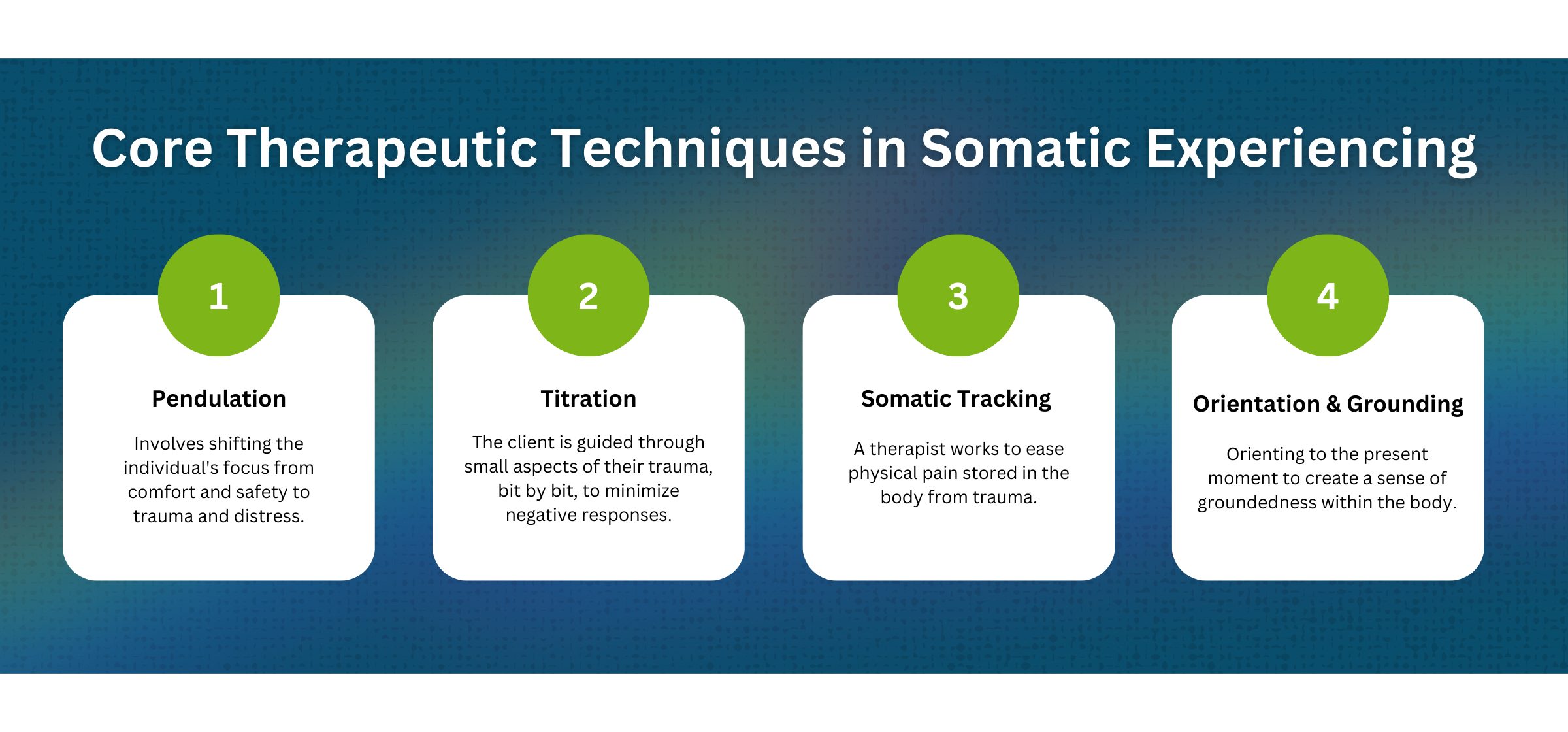
Somatic Experiencing for Trauma Recovery: Integrating Body-Oriented Techniques in Therapy
Somatic experiencing (SE) is a type of body-centered psychotherapy that incorporates a holistic approach to healing from past trauma.
The mind and body store the pain that accompanies scary, stressful and agonizing experiences. SE aims to propel the healing process and resolve the unrest that comes with trauma-related experiences.
We are exploring the ins and outs of somatic experiencing therapy and its potentially profound impact on recovery for individuals struggling to cope with the lasting effects of their trauma.
Introduction to Somatic Experiencing Therapy
While somatics has been around since the 19th century, Peter Levine, Ph.D., introduced the concept of somatic experiencing after spending years studying trauma responses in wild animals.
According to the website for Levine's nonprofit, Somatic Experiencing International (SEI), SE is the result of extensive multidisciplinary study and research on the following:
- Stress physiology
- Psychology
- Ethology
- Biology
- Neuroscience
- Indigenous healing practices
- Medical biophysics
A therapist typically facilitates somatic experiencing. Each session focuses on managing the physiological and nervous system dysregulation that accompanies trauma. The therapist uses different techniques to help restore an individual's ability to self-regulate their bodily responses and ultimately heal from their past.
Somatic Experiencing vs. Other Therapies
- Cognitive processing therapy (CPT): A cognitive behavior therapy focused on identifying and challenging distorted beliefs around a traumatic experience. Unlike SE, CPT concerns itself with mental and emotional processes rather than the body.
- Prolonged exposure therapy (PE): This treatment involves gradual exposure to triggering memories or situations. It highlights the role of avoidance in prolonging the healing process, but it does not emphasize physiological regulation like SE therapy.
- Eye movement desensitization and reprocessing (EMDR): EMDR incorporates repetitive back-and-forth eye movements to promote the processing of traumatic memories. While this style of therapy does not focus primarily on body awareness, it does involve eye movements and physical stimulation similar to SE.
FREE DOWNLOAD: Somatic Exercises & Worksheets

The Role of Body Awareness in Trauma Recovery
Traumatic life events can sometimes cause an individual to disconnect from their body as a means of coping with an overwhelming or terrible experience.
Body awareness plays a critical role in the recovery process as it helps the individual foster an intentional connection between the mind and body. By focusing on physical sensations and emotions in tandem, those receiving therapy can learn how their unique body responds to triggers and stress. This awareness is key to finding effective coping mechanisms.
Somatic trauma therapy aids emotional regulation by doing the following:
- Promoting body awareness
- Calming the nervous system
- Building resilience to triggers
- Completing unresolved trauma responses
- Finding body-based coping strategies
- Fostering the mind-body connection
Who Can Benefit From Somatic Experiencing Therapy?
SE is particularly effective for treating individuals with post-traumatic stress disorder (PTSD). The symptoms of PTSD can be mild or severe, depending on the person and their unique situation. The characteristic symptoms of this disorder include:
- Intrusive thoughts.
- Avoidance of trauma-related stimuli.
- Persistent physiological hyperarousal.
Different SE strategies can help people with PTSD alleviate dysregulation and enhance feelings of stability.
Somatic experiencing can also be an advantageous option for individuals who are overwhelmed with stress. Whether they are dealing with anxiety, panic attacks or insomnia, SE can help patients overcome these symptoms and find peace.
Those with dissociative disorders or tendencies can also benefit from SE therapy. It can help restore a sense of safety, empowerment of self and unity between one's mind and body.

Core Therapeutic Techniques in Somatic Experiencing
- Pendulation: Pendulation is a popular technique for somatic experiencing therapy that involves shifting the individual's focus from comfort and safety to trauma and distress. By practicing tolerance, the client can become more resilient when facing adverse stimuli and stressors. Switching back and forth between these states allows for calmer bodily responses and a greater sense of emotional stability.
- Titration: This technique involves the gradual exploration of traumatic experiences. An SE therapist guides the client through small aspects of their trauma, bit by bit, to minimize negative responses. Titration allows individuals to process and work through their physical and emotional feelings at a pace that feels safe and not overwhelming.
- Somatic tracking: Another useful SE therapy technique is somatic tracking, where a therapist works to ease physical pain stored in the body from trauma. The point is for the client to recognize the pain without emotional reactivity to mindfully examine the discomfort and release it.
- Orientation and grounding: SE therapy patients can benefit from learning how to orient to the present moment and create a sense of groundedness within the body. This can be a form of meditation to soothe the mind and body by bringing awareness away from traumatic or overwhelming memories.
Integrating Somatic Therapy Techniques Into Your Practice
Integrating SE therapy techniques into your practice can be highly advantageous, especially for working with clients suffering from the weight and impact of their traumatic experiences.
As a therapist, you can integrate somatic experiencing techniques into various modalities and treatments to enhance the client's healing process.
By developing trauma-informed care approaches at your practice, you can help those struggling to cope after a traumatic event by offering a safe environment to carefully work through triggers and develop a deeper understanding of trauma and its impacts.
Measuring the Effectiveness of Somatic Experiencing Therapy
In determining whether an SE therapy is effectively helping an individual, therapists must look at a few key factors. The following are signs that SE is benefiting the patient:
- Reduction in trauma symptoms
- Improved emotional resilience
- Practice with useful coping skills and self-regulation
- Greater body awareness and connection
- Resolution of traumatic experiences
Every individual's therapy journey is different, and how quickly they progress and heal will depend on many factors. Your practice can implement SE therapy to help your clients foster long-term improvements and find well-being on the other side of the trauma they've encountered.
Streamline Note-Writing With the Electronic Charting Solution From ICANotes
Somatic experiences can profoundly impact individuals recovering from trauma. With the ICANotes Behavioral Health electronic health record (EHR), you get a fully integrated practice management system with dynamic tools that streamline your daily operations so you can focus on what matters most — providing your clients with effective services.
Our software simplifies documentation with customizable and intuitive notes. Whether you're looking for a robust patient portal or advanced scheduling capabilities with automated appointment reminders, ICANotes has you covered.
Request a free trial or schedule a live demo to see our software in action today!
Start Your Free Trial Today


